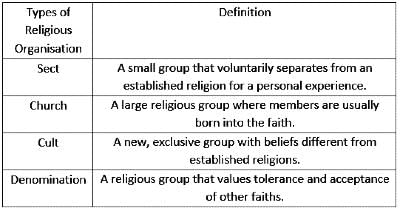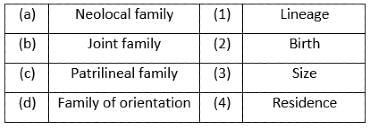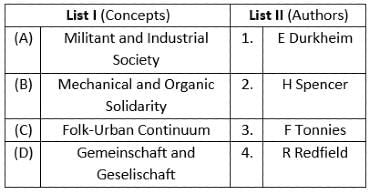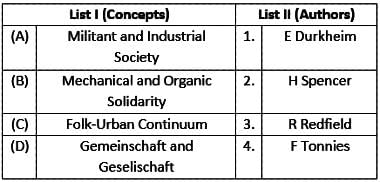CUET PG Exam > CUET PG Tests > Sociology CUET PG Mock Test- 4 - CUET PG MCQ
Sociology CUET PG Mock Test- 4 - CUET PG MCQ
Test Description
30 Questions MCQ Test - Sociology CUET PG Mock Test- 4
Sociology CUET PG Mock Test- 4 for CUET PG 2025 is part of CUET PG preparation. The Sociology CUET PG Mock Test- 4 questions and answers have been prepared
according to the CUET PG exam syllabus.The Sociology CUET PG Mock Test- 4 MCQs are made for CUET PG 2025 Exam.
Find important definitions, questions, notes, meanings, examples, exercises, MCQs and online tests for Sociology CUET PG Mock Test- 4 below.
Solutions of Sociology CUET PG Mock Test- 4 questions in English are available as part of our course for CUET PG & Sociology CUET PG Mock Test- 4 solutions in
Hindi for CUET PG course.
Download more important topics, notes, lectures and mock test series for CUET PG Exam by signing up for free. Attempt Sociology CUET PG Mock Test- 4 | 75 questions in 90 minutes | Mock test for CUET PG preparation | Free important questions MCQ to study for CUET PG Exam | Download free PDF with solutions
Detailed Solution for Sociology CUET PG Mock Test- 4 - Question 1
Sociology CUET PG Mock Test- 4 - Question 2
According to Auguste Comte, which of the following is the characteristic of the Metaphysical Stage of the knowledge?
Detailed Solution for Sociology CUET PG Mock Test- 4 - Question 2
Sociology CUET PG Mock Test- 4 - Question 3
A rising suicide rate associated with normlessness and a lack of social regulation can be described as:
Detailed Solution for Sociology CUET PG Mock Test- 4 - Question 3
Sociology CUET PG Mock Test- 4 - Question 4
The key agencies and mechanisms of formal social regulation are the ______ and __________.
Detailed Solution for Sociology CUET PG Mock Test- 4 - Question 4
Sociology CUET PG Mock Test- 4 - Question 5
Who is the author of the book 'The Religion of Java'?
Detailed Solution for Sociology CUET PG Mock Test- 4 - Question 5
Detailed Solution for Sociology CUET PG Mock Test- 4 - Question 6
Sociology CUET PG Mock Test- 4 - Question 7
After independence, till 1970, the sociological and social anthropological studies have shown a deep concern for which of the following three developments in India?
A. Environmental
B. Cultural
C. Economic
D. Gender
E. Social
Choose the correct answer from the options given below:
Detailed Solution for Sociology CUET PG Mock Test- 4 - Question 7
Sociology CUET PG Mock Test- 4 - Question 8
The reason for the sudden decline in sex ratio can be
Detailed Solution for Sociology CUET PG Mock Test- 4 - Question 8
Detailed Solution for Sociology CUET PG Mock Test- 4 - Question 9
Detailed Solution for Sociology CUET PG Mock Test- 4 - Question 10
Sociology CUET PG Mock Test- 4 - Question 11
Who has used the term 'Serendipity' in sociological research?
Detailed Solution for Sociology CUET PG Mock Test- 4 - Question 11
Detailed Solution for Sociology CUET PG Mock Test- 4 - Question 12
Sociology CUET PG Mock Test- 4 - Question 13
Durkheim is known for his theories on which of the following?
1. Social Facts
2. Anomie
3. Social Stratification
4. Collective Conscience
Detailed Solution for Sociology CUET PG Mock Test- 4 - Question 13
Sociology CUET PG Mock Test- 4 - Question 14
Which of the following institutions is not basic in Giddens definition of modernity?
Detailed Solution for Sociology CUET PG Mock Test- 4 - Question 14
Sociology CUET PG Mock Test- 4 - Question 15
Who has given the statement that "marriage is rooted in the family rather than family in marriage"?
Detailed Solution for Sociology CUET PG Mock Test- 4 - Question 15
Sociology CUET PG Mock Test- 4 - Question 16
A truly global economy implies a boundaryless world where there is,
Detailed Solution for Sociology CUET PG Mock Test- 4 - Question 16
Sociology CUET PG Mock Test- 4 - Question 17
Patterns of unequal access to social resources are commonly called _______. Some social inequality reflects innate differences between individuals. For example, their varying abilities and efforts.
Detailed Solution for Sociology CUET PG Mock Test- 4 - Question 17
Detailed Solution for Sociology CUET PG Mock Test- 4 - Question 18
Sociology CUET PG Mock Test- 4 - Question 19
Consider the following stages of social change as given by Karl Marx
1. Feudal
2. Primitive Communism
3. Ancient
4. Capitalistic
The correct sequence of these stages of social change is
Detailed Solution for Sociology CUET PG Mock Test- 4 - Question 19
Sociology CUET PG Mock Test- 4 - Question 20
With regards to Karl Marx find the incorrect statement?
- He was born in Germany.
- He argued that the industrial society was capitalist and the profit of capitalists was produced by workers
- He believed that to overthrow capitalism, workers had to construct a democratic society where all property was Privately controlled.
Detailed Solution for Sociology CUET PG Mock Test- 4 - Question 20
Detailed Solution for Sociology CUET PG Mock Test- 4 - Question 21
Sociology CUET PG Mock Test- 4 - Question 22
A method which involves a systematic and comprehensive study of a particular community, organization, group with a view to the analysis of a social problem and the presentation of recommendations for its solution is :
Detailed Solution for Sociology CUET PG Mock Test- 4 - Question 22
Sociology CUET PG Mock Test- 4 - Question 23
Who is of the view that incest taboo enables relationship with wider society?
Detailed Solution for Sociology CUET PG Mock Test- 4 - Question 23
Sociology CUET PG Mock Test- 4 - Question 24
Which of the following statements is not true about secularism?
Detailed Solution for Sociology CUET PG Mock Test- 4 - Question 24
Sociology CUET PG Mock Test- 4 - Question 25
Gender Socialisation begins at birth and occurs through all the following major agent of socialisation, except:
Detailed Solution for Sociology CUET PG Mock Test- 4 - Question 25
Sociology CUET PG Mock Test- 4 - Question 26
Match List - I with List - II

Choose the correct answer from the options given below:
Detailed Solution for Sociology CUET PG Mock Test- 4 - Question 26
Sociology CUET PG Mock Test- 4 - Question 27
Which one of the following principles is NOT applicable to sampling?
Detailed Solution for Sociology CUET PG Mock Test- 4 - Question 27
Sociology CUET PG Mock Test- 4 - Question 28
Which theory of feminism argues that girls can meet the same academic standards as boys, provided they face no negative intervention from different socializing agents.
Detailed Solution for Sociology CUET PG Mock Test- 4 - Question 28
Sociology CUET PG Mock Test- 4 - Question 29
There is a feeling of sacrifice and co-operation among the members of this group. Identify the group from the following options.
Detailed Solution for Sociology CUET PG Mock Test- 4 - Question 29
Sociology CUET PG Mock Test- 4 - Question 30
The concepts of sanskritisation and westernisation were developed by
Detailed Solution for Sociology CUET PG Mock Test- 4 - Question 30
View more questions
Information about Sociology CUET PG Mock Test- 4 Page
In this test you can find the Exam questions for Sociology CUET PG Mock Test- 4 solved & explained in the simplest way possible.
Besides giving Questions and answers for Sociology CUET PG Mock Test- 4, EduRev gives you an ample number of Online tests for practice
Download as PDF

















